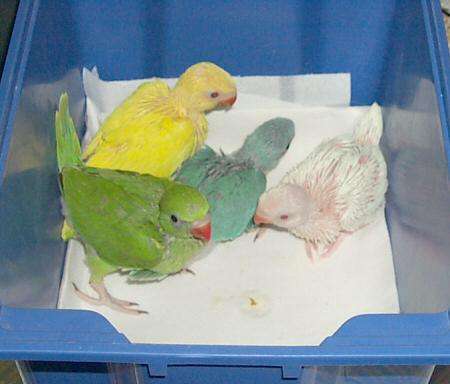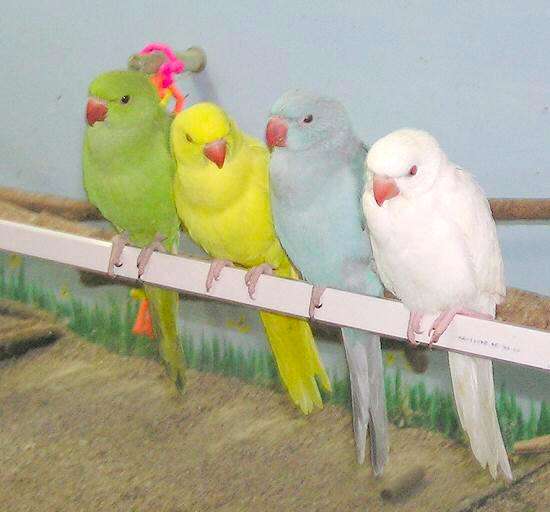|
|
Post by rainbowfeathers77 on Aug 1, 2008 21:36:49 GMT 10
Hi Hubby wants us to get a white tame IRN (me too ofcourse- as if I'm going to protest ;D  ) but anyway...so I've been looking around for breeders and got in contact with one (Yvonne in Penrith NSW) and she told me she has white IRNs. When I asked some more questions, she corrected herself and said that she doesn't have "albinos" , she has pure white irns with dark eyes. Is there such a thing? I had no idea there were such options!? I deffinatelly like a white bird with dark eyes more ...the red eyes is the only thing that doesn't sit with me  So is this true? Can you get either an albino with red eyes or a white bird with dark eyes? PS> I just heard from her again, she said the outside of the iris is kind of reddish but the iris is dark brown. |
|
|
|
Post by avinet on Aug 1, 2008 22:18:28 GMT 10
White ringneck and "albino" ringneck are the same. The eye lis red as a baby but as an adult looks black and the red is only seen if a light is shone into it. It is not a true albino gene but a combination of the lutino (yellow) and blue mutations in the same bird. To simplify a bit a green ringneck doesn't have green feathers but has a combination of blue and yellow feathers which when combined give a green appearance. A lutino results when the blue gene is missing and the blue ringneck occurs when the yellow gene is missing. If the two genes are missing then a white bird results. This means that a male white ringneck doesn't get any neck ring, it stays pure white. Because of the genetics involved in breeding them the majority of white ringnecks around are female, and DNA or surgical sexing is necessary to be sure of the sex. I have a pair of ringnecks about to start laying that sometimes produce a white baby. The hen is lutino split to blue while the cock is green split to lutino, blue and cinnamon. One in 8 babies has the blue and lutino gene combined and is white. Their first ever nest had one each of green, lutino, blue and white - a 1 in 16 chance of it happening and some 10 clutches later they haven't repeated it - photos below. cheers, Mike  The four as babies The four as babies The same four after weaning and in the shop. The same four after weaning and in the shop. |
|
|
|
Post by pinkdevil on Aug 1, 2008 22:35:30 GMT 10
They make a great pastle colour photo. lol  |
|
|
|
Post by Jane on Aug 2, 2008 8:12:59 GMT 10
Beautiful bubs Mike  Thanks for the explanation too, I knew a true albino cockatiel couldn't exist. |
|
|
|
Post by rainbowfeathers77 on Aug 2, 2008 10:19:54 GMT 10
Thanks so much for that info Mike! The birds are beautiful - a true rainbow of colours!!!! You've shown me the first picture once before, when I was planning on getteing four IRNs of the same colour - what a tease  ;D lol Just to clarify the male & female albino - I've been getting a feeling that it seems to be harder to get male albinos compared to female albinos but I still don't understnad why? I'm not very good with genetics and all that  ...also, that is the one question this lady seems to keep avoiding to answer, so I don't know if, yes, they will be a male and she just forgot to answer or I'll get sucked in and get a female, which I CAN'T because it'll disrupt the peace and harmony my irns have at the moment - if they hear a female...they'll kill each other - so there fore it's very importnat that I get a boy. Could you explain to me Mike, why is it difficult to get a male albino compared to the female? |
|
|
|
Post by avinet on Aug 2, 2008 21:57:43 GMT 10
The albino is a combination of a visual lutino and a visual blue, and the lutino is a sex-linked gene and the blue is a recessive gene. This means that both the parents have to carry the blue gene for any of their babies to be blue, and the male has to carry the lutino gene for any of their babies to be lutinos. There are many combinations of colours and splits that can produce an albino but many will only produce hens due to that sex-linked lutino gene. Phil Robson's book on Ringnecks lists 15 different combinations of green, lutino and blue that can produce albinos but only 7 of these can produce male albinos. Hence more hens than cocks are bred.
If you are buying an albino and you want a male be sure to insist that the bird is close rung and has a sexing certificate to show his sex. Don't be impatient and get the first one you find - wait for the right bird, from a reliabvle source that has a bird that has been sexed. And remember that any bird you buy now is a year old and unless it has been kept as a pet bird is unlikely to be still properly socialised. Ringnecks can go feral VERY quickly is not kept well socialised in their first year. This year's babies are not likely to be around for another couple of months yet - mine will be three months at least.
cheers,
Mike
|
|
|
|
Post by fionap on Nov 8, 2015 13:42:35 GMT 10
Hi there, I am new to this forum.
I am looking at buying a bonded pair of IRN's, the male is Blue (visual only, don't know history and I don't think the current owner knows either) and the female is white. What colour babies would they be likely to produce?
Also what would be a fair price for this pair, they are not proven breeders as the current owner has them in an aviary with pink and greys and she thinks they are destroying any eggs there might be.
I am located in WA.
Many thanks for any assistance
Fiona
|
|